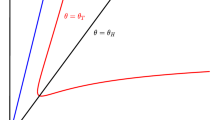Abstract
This work continues the mathematical study started in ([13], to appear) on the analytic aspects of the Lengyel–Epstein reaction diffusion system. This system captures the crucial feature of the CIMA reaction in an open unstirred gel reactor which gave the first experimental evidence of Turing pattern in 1990. In the one dimensional case, we make a detailed description for the global bifurcation structure of the set of the non-constant steady states. The limiting behavior of the steady states is further clarified using a shadow system approach.
Similar content being viewed by others
REFERENCES
Callahan, T.K., and Knobloch, E. (1999). Pattern formation in three-dimensional reaction-diffusion systems. Phys. D 132, 339–362.
Castets, V., Dulos, E., Boissonade, J., and De Kepper, P. (1990). Experimental evidence of a sustained Turing-type equilibrium chemical pattern. Phys. Rev. Lett. 64, 2953–2956.
Crandall, M., and Rabinowitz, P. (1971). Bifurcation from simple eigenvalues. J. Functional Anal. 8, 321–340.
Gierer, A., and Meinhardt, H. (1972). A theory of biological pattern formation. Kybernetik 12, 30–39.
Judd, S.L., and Silber, M. (2000). Simple and superlattice Turing patterns in reaction-diffusion systems: bifurcation, bistability, and parameter collapse. Phys. D 136, 45–65.
Keener, J.P. (1978). Activators and inhibitors in pattern formation. Stud. Appl. Math. 59, 1–23.
Lengyel, I., and Epstein, I.R. (1991). Modeling of Turing structures in the chlorite-iodide-malonic acid-starch reaction system. Science 251, 650–652.
Lengyel, I., and Epstein, I.R. (1992). A chemical approach to designing Turing patterns in reaction-diffusion system. Proc. Natl. Acad. Sci. USA 89, 3977–3979.
Li, Y., Oslonovitch, J., Mazouz, N., Plenge, F., Krischer, K., and Ertl, G. (2001). Turing-type patterns on electrode surfaces. Science 291, 2395–2398.
Murray, J.D. (1989). Mathematical Biology, Springer-Verlag, Berlin.
Ni, W.-M. (1998). Diffusion, cross-diffusion, and their spike-layer steady states. Notices Amer. Math. Soc. 45, 9–18.
Ni, W.-M., Polčik, P., and Yanagida, E. (2001). Monotonicity of stable solutions in shadow systems. Trans. Amer. Math. Soc. 353, 5057–5069.
Ni, W.-M., and Tang, M. Turing patterns in Lengyel-Epstein system for the CIMA reaction, submitted.
Ni, W.-M., Takagi, I., and Yanagida, E. (2001). Stability of least energy patterns of the shadow system for an activator-inhibitor model. Japan J. Ind. Appl. Math. 18, 259–272.
Nishiura, Y. (1982). Global structure of bifurcating solutions of some reaction-diffusion systems. SIAM J. Math. Anal. 13, 555–593.
Opial, Z. (1961). Sur les périodes des solutions de 1 'équation différentielle x″ + g(x) = 0. Ann. Polon. Math. 10, 49–72.
Rabinowitz, P.H. (1971). Some global results for nonlinear eigenvalue problems. J. Functional Anal. 7, 487–513.
Schaaf, R. (1990). Global Solution Branches of Two-point Boundary Value Problems, Lecture Notes in Mathematics, Vol. 1458, Springer-Verlag, Berlin.
Shi, J. (2002). Semilinear Neumann boundary value problems on a rectangle. Trans. Amer. Math. Soc. 354, 3117–3154.
Takagi, I. (1986). Point-condensation for a reaction-diffusion system. J. Diff. Eqns 61, 208–249.
Turing, A.M. (1952). The chemical basis of morphogenesis. Phil. Trans. Roy. Soc. London Ser. B 237, 37–72.
Author information
Authors and Affiliations
Rights and permissions
About this article
Cite this article
Jang, J., Ni, WM. & Tang, M. Global Bifurcation and Structure of Turing Patterns in the 1-D Lengyel–Epstein Model. Journal of Dynamics and Differential Equations 16, 297–320 (2004). https://doi.org/10.1007/s10884-004-2782-x
Issue Date:
DOI: https://doi.org/10.1007/s10884-004-2782-x




